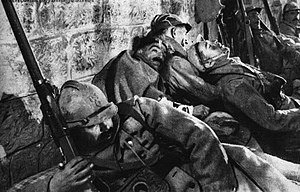Fort Vaux
| Storming of Fort Vaux | |||||||
|---|---|---|---|---|---|---|---|
| Part of the Battle of Verdun, World War I | |||||||
 The exhausted defenders of the fort |
|||||||
|
|||||||
| Belligerents | |||||||
|
|
|
||||||
| Commanders and leaders | |||||||
| Sylvain-Eugene Raynal (POW) | Erich von Falkenhayn | ||||||
| Strength | |||||||
| 600 | 5,200 | ||||||
| Casualties and losses | |||||||
| 163 dead 191 wounded 246 captured |
2,740 dead and wounded | ||||||
|
Verdun is a town and sub-prefecture (arrondissement) of the Meuse department of Lorraine, in north-eastern France.
|
|||||||
Fort Vaux, in Vaux-Devant-Damloup, Meuse, France was built from 1881–1884 for 1,500,000 Francs and housed a garrison of 150 men. Vaux was the second Fort to fall in the Battle of Verdun after Fort Douaumont which was captured by a small German raiding party in February 1916, in the confusion of the French retreat from the Woëvre plain. Vaux had been modernised before 1914 with reinforced concrete top protection like Fort Douaumont and was not destroyed by a German heavy artillery-fire which had included shelling by 16-inch howitzers. The superstructure of the fort was badly damaged but the garrison, the deep interior corridors and stations remained intact when the fort was attacked on June 2 by German assault troops.
The defence of Fort Vaux was marked by the heroism and endurance of the garrison, including Major Sylvain-Eugene Raynal. Under his command, the besieged French garrison repulsed German assaults, including fighting underground from barricades inside the corridors, during the first big engagement inside a fort during World War I. The last men of the French garrison gave up after running out of water (some of which was poisoned), ammunition, medical supplies and food. Raynal sent several messages via homing pigeons (including the famous Vaillant), requesting relief for his soldiers. During his last communications, Major Raynal wrote "This is my last pigeon".
After the surrender of the garrison on June 7, the German army group commander Crown Prince Wilhelm, presented Major Raynal with a French officer's sword as a sign of respect. Raynal and his soldiers remained in captivity in Germany until the Armistice of 11 November 1918. The fort was recaptured by French infantry on November 2, 1916 after an artillery bombardment involving two long-range 400-millimetre (16 in) railway guns. After its recapture, Fort Vaux was repaired and garrisoned. Several underground galleries to reach the far outside, one of them being 1 mi (1.6 km) long, were dug and equipped, the water reserve was quadrupled and light was provided by two electric generators. Some damage from the fighting on June 2 can still be seen. The underground installations of the fort are well-preserved and are currently open to the public for guided visits.
...
Wikipedia

